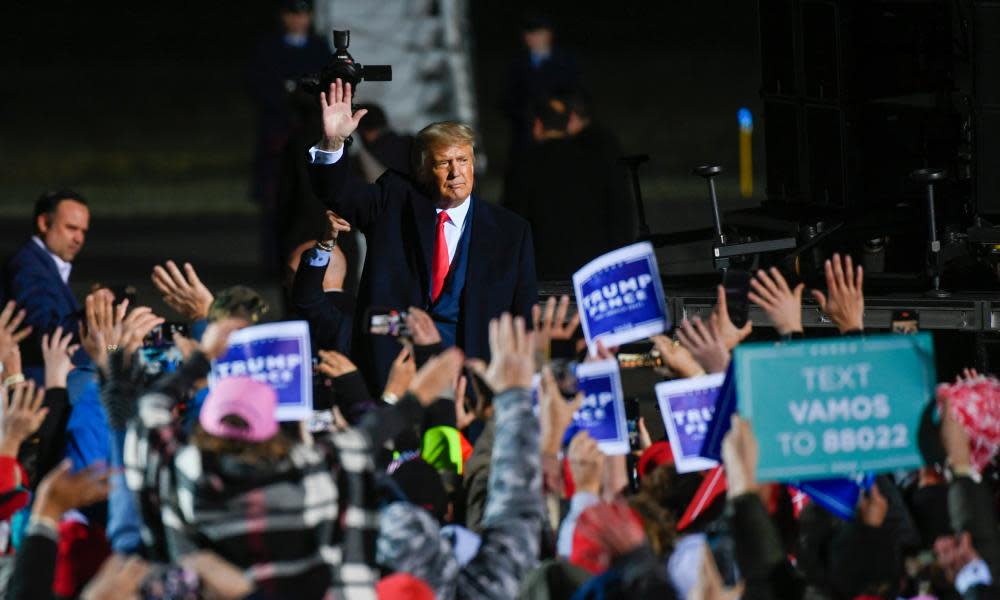Trump relocates planned Wisconsin rally after resistance from local officials

Donald Trump has moved a planned western Wisconsin appearance to elsewhere in the state amid calls from a city mayor and the state’s governor urging him not to hold a rally there due to a surge in coronavirus cases.
A pair of campaign rallies are scheduled for Saturday as the key swing state struggles to control a 22% surge in coronavirus cases over the last week.
Wisconsin ranks third among states for per-capita increases in cases over the past two weeks. State health officials reported 2,887 newly confirmed cases on Thursday, a new daily record, along with 21 more deaths. The state has now seen 125,161 cases and 1,348 deaths since the pandemic began.
Trump replaced a rally in La Crosse with one in Janesville, about 175 miles away, where the virus is not spreading quite as rapidly. He will also hold a rally on Saturday in Green Bay. Both will be outside, at airports. Trump’s decision to visit Janesville prompted authorities there to also request that Trump reconsider.
Both La Crosse and Green Bay have been identified as “red zones” for community spread of Covid-19 by the White House coronavirus taskforce. Janesville is not on the list.
The increasing infections in Wisconsin are part of a national trend of rising cases playing out as the presidential election enters the home stretch and the president, trailing badly in the polls, accelerates his search for votes.
Thousands of people, many unlikely to be wearing masks based on recent rallies, are expected to huddle in open-air crowds to hear Trump speak. Barring a surprise victory elsewhere, Trump needs to win Wisconsin to win re-election.
The campaign plan took shape as a major new study by researchers at Cornell University suggested that Trump is the world’s largest source of misinformation about Covid-19. The findings were based on a comprehensive survey of 38m articles from traditional and online media.
While incidents of coronavirus transmission in open-air environments have not been documented as thoroughly as viral spreading in indoor settings, Wisconsin’s governor, Tony Evers, a Democrat, suggested it was reckless for the president to draw thousands of people together in a “red zone” for transmission.
“The president could do two things: one is maybe not come to these two municipalities and cities that are ranked right up towards the top of all the places in the country [for infections],” Evers said.
“The second thing that could be done is for him to insist that if people are there, they wear a mask. He can make that happen. He could wear one too. Those are the two things that he could do to make sure that it doesn’t become a super-spreader event.”
New daily infections have risen in 25 states in the past week, according to analysis by Axios published on Thursday, with about 43,000 new cases a day on about 935,000 daily tests in the United States.
And the city of Boston hit the brakes on reopening on Wednesday after the state public health department said the city could be a “red zone” for active circulation of the virus. Infection rates were above 7% in some neighborhoods, Marty Walsh, the mayor, said at a news conference, and half the recent cases have been among people under age 29.
Walsh urged people not to hold house parties tied to a weekend football game and told the city’s large student population to observe social distancing guidelines.
“You wanted to come to college in Boston, you wanted to be treated like adults. Well then, act like it,” Walsh said. “We’re asking you to be responsible.”
Republican officials in some states have followed Trump’s lead in relaxing or ignoring coronavirus mitigation measures even as cases rise nationally. Governor Tate Reeves of Mississippi, where new case numbers are flat, allowed a statewide mask mandate to expire on Wednesday.
“There is a difference between being wise and being a government mandate,” Reeves said.
The Republican governor of Missouri, Mike Parson, who is running for re-election, defended himself this week over reports that an outbreak of dozens of cases at a military veterans’ home in Missouri followed his campaign visit there.
Parson and his wife later tested positive for Covid-19. A spokesperson for the candidate told the local Riverfront Times “there is no connection between the two”.
Trump also denies that his campaign events have spread the virus.
“So far, we’ve had no problem whatsoever,” he said during the presidential debate on Tuesday night. “It’s outside. That’s a big difference, according to experts. We do them outside. We have tremendous crowds, as you see.”
But Trump does not always “do them outside”. Local health officials tied a Trump rally in Tulsa, Oklahoma, that drew more than 6,000 people into an arena in July to an outbreak of hundreds of cases in the area. Trump supporter Herman Cain, the businessman and former presidential candidate, died of Covid-19 after attending the event.

Trump “was likely the largest driver of the Covid-19 misinformation ‘infodemic’”, the Cornell study suggested. “We found that media mentions of US president Donald Trump within the context of Covid-19 misinformation made up by far the largest share of the infodemic,” the researches wrote.
“Trump mentions comprised 37.9% of the overall misinformation conversation, well ahead of any other topics.”
In reply to criticism over a campaign rally in Nevada last month, Trump explained to a local paper that the risks from such events were small – for him.
“I’m on a stage and it’s very far away,” Trump he said. “And so I’m not at all concerned.”
Agencies contributed reporting

 Yahoo News
Yahoo News 
